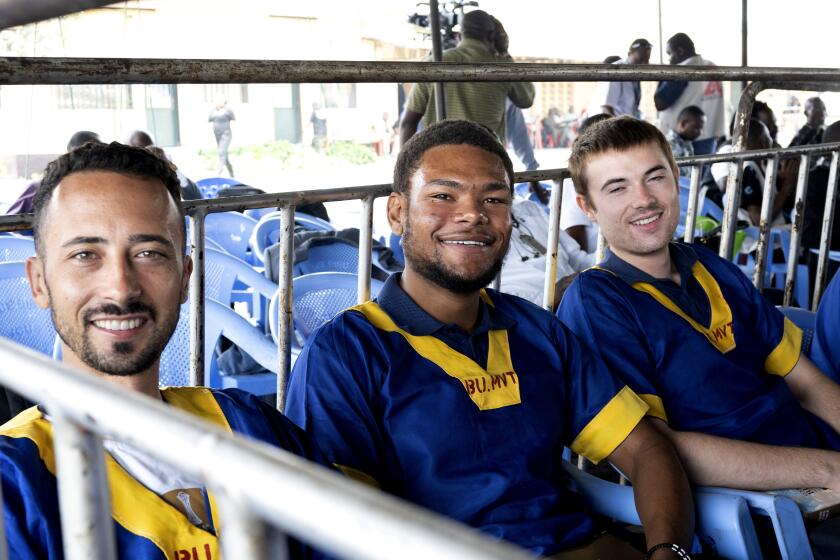Acting in a different theater of war
On his fifth Memorial Day holiday as a U.S. soldier, Spc. Erik Oropeza had much to reflect on.
Only 22, he has felt the earth shudder from mortar and bomb blasts, faced down enemies who outnumbered and outgunned him, and seen good friends die. While others took Monday off to enjoy picnics with their families, Oropeza’s thoughts were with the men who stood with him through the test of combat.
“I don’t celebrate Memorial Day like other people do,” he said. “It’s a sad day for me.”
This year, Oropeza was awarded the Army’s second-highest decoration for valor. And now the quiet young soldier has a new role: helping to train those headed for combat.
Oropeza spends his days at the National Training Center at Ft. Irwin pretending to be an Iraqi or Afghan soldier. But it was the experience of real combat that prepared him for the job, he said, a job he hopes will help other men and women carry out their missions and stay alive.
The son of Mexican immigrants, Oropeza grew up in Boyle Heights, where his earliest struggles were with gang members who stole his lunch money. He was the first in his family to join the Army. Inspired by war movies and moved by a call to duty after watching TV coverage of the conflict in Iraq, he enlisted after graduating from Roosevelt High School in 2004.
Assigned to an infantry regiment based at Ft. Lewis, Wash., he landed in Iraq in April 2007, part of the troop surge to arrest the bloodshed in Baghdad.
His platoon was assigned to support an Iraqi police station on a major supply route north of the capital, near the city of Taji. The police compound was attacked almost daily by insurgents taking cover in nearby palm groves. On Oropeza’s first day, a mortar round slammed to the ground about 30 feet from him, seriously injuring two other soldiers.
He recalled how the force of the blast “just dropped my heart.” But his unit quickly grew accustomed to the gunshots and explosions. It bothered them, he said, only when they were trying to sleep.
Although trained as a rifleman, Oropeza learned to tackle any job handed to him in Iraq. When a driver was injured in a mortar strike, Oropeza was assigned to take his place at the wheel of a 20-ton armored Stryker troop carrier.
On the morning of May 22, 2007, he was driving the first of two Strykers on patrol when they were ambushed. Staff Sgt. Thomas Lee got permission from the platoon sergeant in the other vehicle to turn down a dirt road and flank the attacking gunmen.
“Just be careful,” said Sgt. 1st Class Kim Mendez.
As Oropeza eased the Stryker down the road, he could see men armed with Kalashnikovs popping up from behind berms and weaving between palm trees. When Lee spotted a concrete tower covered with netting, he ordered Oropeza to stop and reverse a bit, thinking it might be hiding a sniper. As Oropeza reversed, a bomb made of 13 155-mm artillery shells erupted through the floor of the vehicle.
“I don’t remember the blast, just a white light and a bunch of smoke and debris,” Oropeza said softly.
The Stryker’s radio and electronic systems went dead, and the blast blew open all the hatches. He hoisted himself out of the driver’s cab, ran around the side and dived into the passenger section.
“I could hear bullets whizzing by and hitting the Stryker,” he said.
Oropeza grabbed a carbine that was lying on top of the truck and started firing back at five gunmen. He had no idea whether there was a grenade in the attached launcher, but he pulled the trigger and ducked for cover. There was an ear-piercing bang. Then quiet.
Oropeza turned to the wounded. Staff Sgt. Kristopher Higdon and Pvt. Robert Worthington were killed instantly. Of the three survivors, Lee was in the gravest condition. Oropeza found the staff sergeant lying inside the blast hole, staring up at him. He was missing a leg and his face was turning a pale blue.
Oropeza grabbed hold of Lee’s bleeding stump and secured a tourniquet around it as tightly as he could. He then waved from a hatch, hoping to catch the attention of his platoon sergeant and a medic about 100 yards away. No response.
“I remember just seeing this dirt road and thinking, I know for a fact if I go down this road, these guys are going to kill me,” Oropeza said. “But I knew if I didn’t get the medic, Sgt. Lee was going to die. So I picked up a magazine and came out shooting.”
Oropeza ran through a barrage of gunfire, shooting back over his shoulder Rambo-style. The commotion caught the attention of the other soldiers, who were in a firefight on the main road. They provided welcome cover fire. When he reached them and described the casualties, a helicopter was called in to evacuate the injured.
When the fight was over, the surviving soldiers were given two days off for a memorial service for Higdon and Worthington.
Then they were back in the fight for another 12 months.
Army officials say Oropeza’s actions that day prevented his vehicle from being overrun and saved the lives of his wounded crew members. In February, he became the 21st soldier to receive the Distinguished Service Cross since the start of the wars in Afghanistan and Iraq. His former commanders flew in from Germany for the ceremony at Ft. Irwin. Lee also made a surprise appearance.
Oropeza, who wears a bracelet engraved with the names of those he could not save, is uncomfortable with the fuss. He says he was just doing his job.
In his new assignment, he says he is glad to be close to home. In March he married his high school sweetheart, Erica. When he gets out of the Army, they plan to open a sports bar together. Until then, he says, his priority is to “keep on doing my job, preparing these guys that are going over there.”
At the base in the Mojave Desert, the military has re-created slices of Iraq and Afghanistan, with bustling villages, hidden tunnels and simulated ambushes to test brigades before they deploy.
When members of the North Carolina National Guard passed through recently en route to Iraq, Oropeza put on Marine desert camouflage, one of the uniforms used by Iraqi soldiers, and joined them on patrols through a village dubbed Abar Layla.
Although he is all too familiar with actual combat, Oropeza says it can feel startlingly real when a pyrotechnics team sets off an explosion, fake blood spurts from painted-on wounds, and actors scream. So much so that rather than hang back like an inexperienced and underequipped Iraqi might do, Oropeza sets off again in pursuit of his foes.
--
More to Read
Sign up for Essential California
The most important California stories and recommendations in your inbox every morning.
You may occasionally receive promotional content from the Los Angeles Times.










